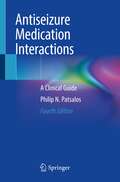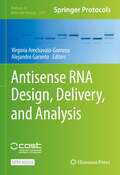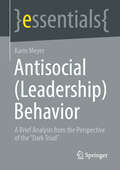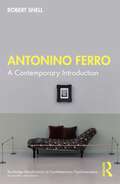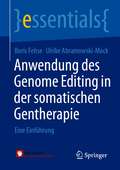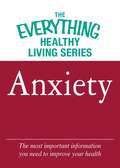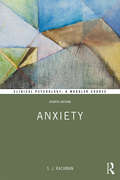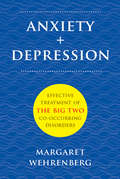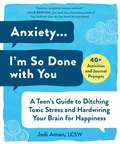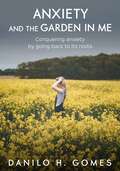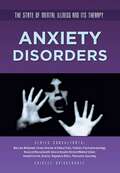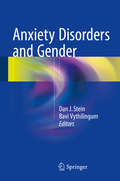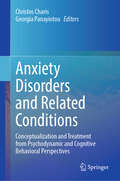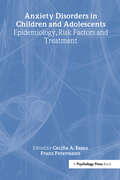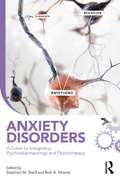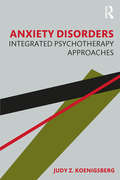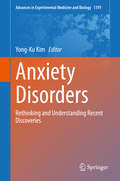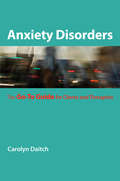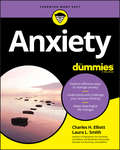- Table View
- List View
Antiseizure Medication Interactions: A Clinical Guide
by Philip N. PatsalosThis significantly revised fourth edition provides a practically orientated guide to interactions associated with antiseizure medications. It describes pharmacokinetic and pharmacodynamic antiseizure medication (ASM) interactions, including details of the magnitude and mechanism of interactions, and also of drug combinations that are not associated with interactions and therefore can be co-prescribed without undue concern. Presented in alphabetical order and by drug class, drug interactions that occur between ASMs and also between ASMs and non- ASMs are described in three sections: Drug interactions between ASMs; Drug interactions between ASMs and non- ASM Drugs: Interactions affecting ASMs; Drug interactions between ASMs and non ASM Drugs: Interactions affected by ASMs. The latest data on all drug interactions is presented. New agents discussed include cannabidiol, cenobamate, everolimus and fenfluramine,. Antiseizure Medication Interactions: A Clinical Guide, 4th Edition concisely presents the most recent developments and data available on the topic. Therefore, enabling physicians and allied health professionals to make more rational choices when ASM polytherapy regimens are required. It will be of interest to medical professionals in disciplines including neurology, psychiatry and pediatrics.
Antisense RNA Design, Delivery, and Analysis (Methods in Molecular Biology #2434)
by Virginia Arechavala-Gomeza Alejandro GarantoThis open access volume gathers a variety of models, delivery systems, and approaches that can be used to assess RNA technology for exploiting antisense as a therapeutic intervention. Beginning with a section on the design of antisense technology and their delivery, the book continues by covering model systems developed to evaluate efficacy, both in vivo and in vitro, as well as methods to evaluate preclinically the toxicity associated with these new potential drugs, and intellectual property considerations. Written for the highly successful Methods in Molecular Biology series, chapters include introductions to their respective topics, lists of the necessary materials and reagents, step-by-step, readily reproducible laboratory protocols, and tips on troubleshooting and avoiding known pitfalls. Authoritative and practical, Antisense RNA Design, Delivery, and Analysis provides basic knowledge and a large collection of methods to facilitate the work of newcomers to this vibrant and expanding field. This book was conceived thanks to the network DARTER (Delivery of Antisense RNA Therapeutics). DARTER is funded by the EU Cooperation of Science and Technology (COST), which aims to enhance interaction and collaborations between researchers in Europe and other countries.
Antisocial Behavior
by Benjamin B. WolmanAntisocial behavior takes on many forms, from rebellious teens with green hair and pierced skin to the truly dangerous homicidal individuals whose horrible stories fill our newspapers. Parents worry about their children as they are exposed to the heatedclimate of violence in contemporary society, a time of decaying morals and values.The rise in sociopathic behavior among adults and children, whether in tense inner cities or in tranquil suburban and rural settings, is masterfully chronicled by Dr. Benjamin B. Wolman, a leading psychologist and noted national expert who has studied these trends for over half a century. "There is a growing incidence of sociopathic antisocial behavior . . . coupled with an attitude of moral apathy," Dr. Wolman asserts. He cites international statistics pointing to a showdown between dangerous individuals-the violent, the charming, and the passive-and the societies that create them.How has the spread of democratic ideals actually increased the potential for antisocial behavior? What social and cultural factors must be changed if free societies are to reduce this alarming trend?Rather than simply complain about the problem, Dr. Wolman examines the familial and societal causes, and proposes clear-cut solutions to the problem-including radical changes to our educational system and the mass media.
Antisocial Behavior and Mental Health Problems: Explanatory Factors in Childhood and Adolescence
by Rolf Loeber David P. Farrington Magda Stouthamer-Loeber Welmoet B. Van KammenEpidemiological surveys have provided key information about the prevalence and degree of seriousness at different ages of a wide array of problem behaviors such as delinquency, substance use, early sexual involvement, and mental health disorders. Knowledge of the extent of these problems and changes in their course over time is important. In its absence, interventions and health planning in general can be difficult. Understanding which risk and protective factors are relevant to which problem behaviors is also essential for the formulation of theories that constitute the basis of intervention. This book draws on the results of the major Pittsburgh Youth Study complemented by follow-up tracking of juvenile court records for more than six years, to address the following questions: *What is the prevalence and age of onset of delinquency, substance use, and early sexual behavior for three samples of boys age 8, 11, and 14? What are the average mental health problems for these ages? How strong are the relationships among these problem behaviors in each of the samples? *Which variables best explain individual differences among the boys in their manifestations of delinquency, substance use, early sexual behavior, and mental health problems? To what extent do explanatory factors vary with age? How accurately can boys with different outcomes be identified by risk scores based on hierarchical multiple regressions? *To what extent are explanatory factors associated with one outcome that are also associated with other outcomes? Are explanatory factors that are especially characteristic of a multiproblem group of boys--who display many different problem behaviors--different from explanatory factors associated with boys with few problems? *Do the results fit a general theory of juvenile problem behaviors, or is a differentiated theory more applicable?
Antisocial, Narcissistic, and Borderline Personality Disorders: A New Conceptualization of Development, Reinforcement, Expression, and Treatment
by Daniel J. FoxThis book provides a framework for scholars and clinicians to develop a comprehensive and dynamic understanding of antisocial, narcissistic, and borderline personality disorders, by seeing personality as a dual, as opposed to a singular, construct. Converging the two separate research and clinical diagnostic systems into a wholistic model designed to reach reliable and valid diagnostic conclusions, the text examines adaptive and maladaptive personality development and expression, while addressing the interpersonal system that keeps the pathology from extinguishing. Each chapter will discuss core and surface content, origin and symptom manifestation, system and pathology perpetuation, and online behavior expression, concluding with practical guidance on treatment success and effective approaches. Seasoned and tyro researchers and clinicians will be challenged to explore the utility of the DSM-5 alternative model of personality disorders and apply it to further the understanding of these complex, and often destructive, disorders.
Antisocial: A Brief Analysis from the Perspective of the "Dark Triad" (essentials)
by Karin MeyerNarcissism is considered a widespread phenomenon at leadership levels, where it is represented disproportionately compared to the general population. Furthermore, younger emerging (leadership) talents exhibit significantly higher levels of narcissism than older generations have shown to date. At the same time, traits of the Dark Triad (narcissism, machiavellianism, and psychopathy) often do not occur in isolation, but rather in combination. For this reason, companies should rethink their personnel selection, management, and development practices today. This analysis will therefore highlight the characteristics and behavior patterns of ruthless individuals from the Dark Triad, as well as possible approaches for intervention and prevention.
Antisoziales: Eine Kurzanalyse aus der Perspektive der „Dunklen Triade“ (essentials)
by Karin MeyerNarzissmus gilt auf Führungsetagen als ein verbreitetes Phänomen, das dort im Vergleich zur restlichen Bevölkerung überdurchschnittlich stark repräsentiert ist. Weiterhin weisen jüngere Nachwuchs(führungs-)kräfte deutlich höhere Narzissmus-Ausprägungen auf als dies in den älteren Generationen bislang der Fall war. Gleichzeitig treten Verhaltenszüge der Dunklen Triade (Narzissmus, Machiavellismus und Psychopathie) meist nicht isoliert, sondern in Kombination auf. Unternehmen sollten aus diesem Grund schon heute ihre Personalauswahl, -führung und -entwicklung überdenken. Beleuchtet werden daher Merkmale und Verhaltensmuster rücksichtsloser Personen der Dunklen Triade – ebenso mögliche Ansätze zur Intervention und Prävention.
Antonino Ferro: A Contemporary Introduction (Routledge Introductions to Contemporary Psychoanalysis)
by Robert SnellThis book provides a clear, thorough, and accessible introduction to the work of Antonino Ferro and draws on the clinical vignettes that punctuate his writings to show how Ferro has built on Bion’s revolutionary achievements to develop a distinctive, game-changing version of field theory in psychoanalysis.The book clarifies the phenomenological insight that the analyst and the patient together generate an ever-evolving, intersubjective field. Rather than the supposed psychology of the individual, it is this populous and multidimensional field, a co-created ‘in-between’ rich in characters and stories, that is to be explored and elaborated. The primary points of access to this new ‘multiverse’ are dream, reverie, metaphor, and imagination. A radical Negative Capability is called for, not least to help dissolve co-constructed ‘bastions’ obstructing the field’s expansion. The book sketches out the Italian and international context in which Ferro developed his thinking and addresses some key critical questions. It concludes that Ferro’s life’s work, which marries theoretical rigour with a revitalising increase in playfulness and freedom of response, is a transformational force within psychoanalysis and a major catalyst in its evolution.This important volume is rewarding reading for beginning and seasoned analysts alike, as well as for psychotherapists, counsellors, humanities scholars, and anyone interested in psychoanalysis.
Anwendung des Genome Editing in der somatischen Gentherapie: Eine Einführung (essentials)
by Boris Fehse Ulrike Abramowski-MockDieses essential gibt einen Überblick über Grundlagen sowie Chancen und Risiken der Gentherapie, mit besonderem Fokus auf das Genome Editing. Es werden aktuelle und zukünftige klinische Anwendungen der neuen, mit vielen Hoffnungen, aber auch Ängsten verbundenen Technologien diskutiert.
Anxiety
by Adams MediaIf you or a family member is suffering from anxiety, you may feel overwhelmed by the challenges associated with this condition. The Everything® Healthy Living Series is here to help. These concise, thoughtful guides offer the expert advice and the latest medical information you need to manage your pain and lead a healthy life.Inside you’ll find expert advice and helpful tips on understanding anxiety, seeking help from therapist and support groups, finding the best medications and treatments, and thoughtful advice on helping family and friends understand your condition. Living with depression can be challenging, but with the right guidance you can live a happy and healthy life.
Anxiety
by Stanley J. RachmanAnxiety is a complex phenomenon and a central feature of many psychological problems. This thoroughly revised edition of Anxiety has been updated to include astonishing developments in the in the clinical implementation of knowledge about anxiety. In particular, this edition updates the reader with: A new chapter on health anxiety A fully updated chapter on obsessive compulsive disorders, including the concept of mental contamination and the causes of obsessions An account of advances in therapeutic techniques. Unique in combining an introduction to the subject with comprehensive coverage of the latest developments in research and practice, this book provides excellent breadth and depth of coverage which all practicing and trainee clinical psychologists, and students of clinical psychology, will find extremely informative.
Anxiety (Clinical Psychology: A Modular Course)
by Stanley J. RachmanAnxiety is a complex phenomenon and a central feature of many psychological problems. This new edition of Anxiety, part of the popular Clinical Psychology: A Modular Course Series, updates the remarkable developments that have occurred in the understanding of Anxiety and the astonishing dissemination of effective methods of treatment. This book details the growth of positive psychology, with its emphasis on learned optimism and resilience, is influencing clinical psychology and psychological therapy, and explains the new concept of prospection, a key element in positive psychology based on the human ability to imagine thoughts and images about the future. It is said that we are influenced by the past but drawn into the future, and this notion has significant implications for anxiety. The recent infusion of positivity into theorising about anxiety, has introduced a welcome balance into our understanding of this phenomenon. This informative book covers the latest developments in research, therapy and theorising, containing numerous case-history illustrations about Anxiety. It should appeal to practising and trainee psychologists and practitioners in related fields.
Anxiety + Depression: Effective Treatment of the Big Two Co-Occurring Disorders
by Margaret WehrenbergTips and techniques for managing a prevalent co-existing condition. Anxiety and depression are two of the most common complaints in therapy, and its not unusual for clients to suffer from both simultaneously. But spotting the co-occurrence is not easy. When one symptom picture dominates, diagnosis and treatment are pretty straightforward. But consider how fuzzy the clinical picture can become: Depression can rob an anxious client of the energy needed to control her symptoms; acute anxiety can make anyone depressed and exhausted; and what happens when anxiety masquerades as depression, or vice versa? What are the signs that this is happening? It's hard enough to treat these two disorders when they exist on their own, and it gets even harder when they present together. In her customary practical style and conversational tone, Margaret Wehrenberg unravels the complexity of this common comorbidity, teaching therapists exactly how to tackle it. Beginning with "Where to Start?", she walks readers through a variety of common tricks for distinguishing between anxiety and depression, and provides an assessment plan for determining which set of symptoms the client is most ready to work on. The book goes on to highlight seven common types of comorbid clients, who can be arrayed on a spectrum, from the "low energy" (depressed) on one end to the "high anxiety" (anxious) on the other, and everything in between, including the "hopeless ruminator," the "quiet avoider," and the "high-energy anxious and depressed" client. By organizing the book around these typical client profiles, readers are given a more realistic picture of what comorbid anxiety and depression look like and how to best help their clients. Wondering where depression ends and anxiety begins, or vice versa, and how you can most effectively help your clients when they're struggling with both? The key clinical strategies offered in this book provide a practical roadmap forward, helping therapists and their clients to better understand the symptom picture, manage its effects, and heal.
Anxiety . . . I'm So Done with You: A Teen's Guide to Ditching Toxic Stress and Hardwiring Your Brain for Happiness
by Jodi AmanA Practical Guide with Activities to Help You Break Out of Depression and Anxiety Are you feeling stressed out, anxious, and alone? Do you stay up at night wondering if it will all work out? And how will you handle it when it doesn&’t? Do you double down on your efforts to be smart enough, cool enough, able enough, only to make everything worse? Is anxiety sucking the life out of you? If you are familiar with these feelings—and want a way out—this book is for you. Teenagers, especially, are supposed to be carefree and energetic, but today&’s Gen Z is anything but free. We are exposed to political conflict, environmental disaster, and community violence daily. Life seems so out of control! In addition, competition encouraged by social pressures and social media has damaged our self-confidence, making our culture a petri dish where low self-esteem, anxiety, and depression grow. This workbook shows you the way out. Learn to build trust in your skills and abilities so you can create your own life instead of being a passive recipient of it. Learn how to get rid of anxiety, let go of perfectionism, and experience lasting happiness. Learn the Biology behind Anxiety—What It Is and What It Isn&’tIdentify the Lies that Anxiety Tells YouActivate Your Own Agency—Your Confidence, Motivation, and Unique SkillsEmbrace an Attitude of Self-AcceptancePractice Happy Habits Daily
Anxiety And The Garden In Me: Conquering anxiety by going back to its roots
by Danilo H. GomesThere is a seemingly invincible monster that, at this very moment, haunts the lives of countless people around the world. This monster called anxiety has devastated souls like a hurricane that destroys everything on its way. Knowing the Perfect Gardener and the garden of the soul, we see a light at the end of the tunnel for anxious souls. ANXIETY AND THE GARDEN IN ME is a Christian work that promotes mainly philosophical self-knowledge while working on faith in the Creator. A short but profound book. Beat your anxiety while getting to know your inner garden better.
Anxiety Disorders (The State of Mental Illness and Its Ther #19)
by Shirley BrinkerhoffWhen terrorists attacked the World Trade Center on September 11, 2001, Cassie McCauley watched in horror from her classroom on the New Jersey side of the Hudson River. Her heart pounded faster and faster as she saw billowing clouds of dark gray smoke pour from the landmark buildings. When the first tower collapsed, she began feeling light-headed. By the time the second tower fell in on itself, Cassie was so nauseated and dizzy she had to sit down. Along with millions of people across North America and around the world, Cassie grieved for the families who lost relatives and friends. But she never anticipated the changes September 11 would cause in her own life. Soon she found herself unable to go to school and barely able to function. Cassie was experiencing an anxiety disorder. Anxiety disorders are the most common psychiatric illnesses in North America. Estimates are that at least one of every twenty Americans will suffer from an anxiety disorder at some time. These disorders can happen for many reasons. As in Cassie's case, they can be triggered by traumatic and devastating events. In other cases, they can appear seemingly without reason. Nearly everyone at one time or another experiences anxious feelings, so some people assume that an anxiety disorder is not a serious condition. In Anxiety Disorders, however, you will learn how serious anxiety disorders can be. Through Cassie's story, and the stories of other people like her, you will explore the many different forms of anxiety disorders, the impacts they have on people's lives, and the treatments available to help. Discover just how prevalent anxiety disorders are and learn about the new ways doctors are fighting these all-too common forms of mental illness.
Anxiety Disorders and Gender
by Dan J. Stein Bavi VythilingumAnxiety and related disorders are common conditions that disproportionately affect women. In this book, the epidemiology, psychobiology, diagnosis, evaluation, pharmacotherapy and psychotherapy of major anxiety and related disorders are examined with special reference to the effects of gender and sex on clinical presentation and treatment. The conditions considered include generalized anxiety disorder, obsessive-compulsive disorder, panic disorder, posttraumatic stress disorder and social anxiety disorder. In addition, the management of anxiety and related disorders during pregnancy and lactation are discussed. Two concluding chapters specifically address anxiety disorders in women and in men, summarizing key points for clinicians and researchers. The authors are leading clinicians, including both psychiatrists and psychologists, from around the globe.
Anxiety Disorders and Related Conditions: Conceptualization and Treatment from Psychodynamic and Cognitive Behavioral Perspectives
by Christos Charis Georgia PanayiotouThe volume aims to instigate a dialog between the psychoanalytic and the cognitive-behavioral tradition on conceptualization and treatment of anxiety disorders and related conditions through contributions of respective experts. It presents current findings, and current theories and conceptualizations with regards to the mechanisms of etiology and maintenance of anxiety and related conditions, as well as innovative, new or experimental approaches to treatment that target core difficulties found in patients with anxiety. The book integrates basic research with conceptualization and treatment, while giving space for multiple perspectives to treatment, both psychotherapeutic and pharmacological, to be described. Chapters include a) conceptualization and treatment of anxiety and panic from psychodynamic perspectives, b) 2nd wave CBT treatment and the use of virtual reality, c) 3rd wave (ACT) perspectives, and d) neuroendocrine factors, and e) pharmacotherapy perspectives. Different theoretical approaches are presented highlighting the strengths and the evidence in favour of each approach, without promoting any specific perspective, but with an effort to highlight common underlying themes like safety behaviors and avoidance, social support, and role of learning history. In this way the book will present a combination of theory, science and practice aiming to be an excellent resource for researchers, clinicians and students of mental health professions.
Anxiety Disorders in Children and Adolescents: Epidemiology, Risk Factors and Treatment
by Cecilia A. Essau Franz PetermannRecent years have seen a growing awareness of the common occurrence of anxiety disorders in children and adolescents. There has been a parallel increase in the number of studies examining the risk factors, comorbidity, course and outcome of such disorders, as well as the developments of numerous preventative and intervention strategies.The aim of Anxiety Disorders in Children and Adolescents is to present a comprehensive summary of the most recent empirical findings in this area. Written by eminent researchers and clinicians from Europe and America, the book is divided into three broad sections. The first provides a general overview of anxiety disorders in the young, outlining classification and assessment strategies as well as research methods and design. Part two contains chapters on the seven subtypes of anxiety disorder, including panic disorder, obsessive-compulsive disorder and posttraumatic stress disorder. The final section deals with the progress that has been made in the understanding of such disorders and provides recommendations for future investigation.Anxiety Disorders in Children and Adolescents is intended for students, researchers and other professionals in the fields of psychology, psychiatry, pediatrics and social work.
Anxiety Disorders: A Guide for Integrating Psychopharmacology and Psychotherapy (Clinical Topics in Psychology and Psychiatry)
by Stephen M. Stahl Bret A. MooreDrs. Stephen M. Stahl and Bret A. Moore have created an instant classic in Anxiety Disorders: A Guide for Integrating Psychopharmacology and Psychotherapy. Anxiety Disorders is a comprehensive reference for the psychiatry and psychology student, intern, or resident, early career psychiatrist or psychologist, and the busy clinician. It distills the most important information regarding combined treatments for anxiety and presents the material in an easily accessible, understandable, and readable format. Each chapter addresses a specific type of disorder: PTSD, panic, generalized anxiety, obsessive-compulsive and other disorders, and is authored by prominent clinicians with years of experience in providing integrated, individualized treatments. With its thorough exploration of psychopharmacological treatments, psychosocial treatments, and, crucially, the integration of the two, Anxiety Disorders is a text no 21st-century clinician or student can afford to be without.
Anxiety Disorders: Integrated Psychotherapy Approaches
by Judy Z. KoenigsbergThis text provides integrated and unified treatment frameworks for anxiety disorders and examines how contemporary integrated psychotherapy treatment models from different therapeutic interventions can be used to help patients. Dr. Koenigsberg provides a research-based overview of major themes that underlie these treatment models, then analyzes the symptoms and causes of specific anxiety disorders such as panic disorder, social anxiety disorder, and phobias, as well as obsessive-compulsive disorder, and posttraumatic stress disorder. Case studies of integrated or unified treatment approaches are provided for each disorder, along with the theoretical and technical factors that are involved in applying these approaches in clinical practice. Supplementary online materials include PowerPoint slides and test questions to help readers further expand their understanding of integrated and unified approaches for the anxiety disorders and assess their newfound knowledge. Graduate and undergraduate students, novice and seasoned therapists, and researchers will learn the rationale for and the history of past and contemporary integrated and unified models of treatment to gain better insight into anxiety disorders.
Anxiety Disorders: Rethinking and Understanding Recent Discoveries (Advances in Experimental Medicine and Biology #1191)
by Yong-Ku KimThis book reviews all important aspects of anxiety disorders with the aim of shedding new light on these disorders through combined understanding of traditional and novel paradigms. The book is divided into five sections, the first of which reinterprets anxiety from a network science perspective, examining the altered topological properties of brain networks in anxiety disorders. The second section discusses recent advances in understanding of the neurobiology of anxiety disorders, covering, for example, gene-environmental interactions and the roles of neurotransmitter systems and the oxytocin system. A wide range of diagnostic and clinical issues in anxiety disorders are then addressed, before turning attention to contemporary treatment approaches in the context of novel bio-psychosocial-behavioral models, including bio- and neurofeedback, cognitive behavioral therapy, neurostimulation, virtual reality exposure therapy, pharmacological interventions, psychodynamic therapy, and CAM options. The final section is devoted to precision psychiatry in anxiety disorders, an increasingly important area as we move toward personalized treatment.Anxiety Disorders will be of interest for all researchers and clinicians in the field.
Anxiety Disorders: The Go-To Guide for Clients and Therapists (Go-To Guides for Mental Health)
by Carolyn DaitchA comprehensive and accessible book on anxiety for clients and therapists alike. Anxiety disorders are the number-one psychiatric problem in the United States, yet many clients who suffer from anxiety do not get effective counseling, and they often end therapy without successful amelioration of their symptoms. Carolyn Daitch, a seasoned therapist and award-winning author, has found that clients bene?t most when they are active participants in their therapy, and should be knowledgeable about anxiety disorders to facilitate this process. For the bene?t of both therapists and clients, she covers the ins and outs of the anxiety disorders--Generalized Anxiety Disorder, Panic Disorder, Speci?c Phobias, Social Anxiety Disorder, and Obsessive Compulsive Disorder--and offers numerous case examples of those who have sought treatment for these disorders and learned to manage them. For each type of anxiety disorder, she details speci?c treatment options and techniques, explaining which are best suited to individual use, and which are better done in collaboration with a therapist. Engaging, comprehensive, and reassuring, this is an essential Go-To Guide.
Anxiety Disorders: Theory, Research and Clinical Perspectives
by Helen Blair Simpson Yuval Neria Roberto Lewis-Fernández Franklin SchneierAnxiety disorders are amongst the most common of all mental health problems. Research in this field has exploded over recent years, yielding a wealth of new information in domains ranging from neurobiology to cultural anthropology to evidence-based treatment of specific disorders. This book offers a variety of perspectives on new developments and important controversies relevant to the theory, research, and clinical treatment of this class of disorders. Clinicians will find reviews of state-of-the-art treatments for panic disorder, social anxiety disorder, phobias, obsessive-compulsive disorder, generalized anxiety disorder, and post-traumatic stress disorder, as well as controversies over diagnostic and treatment issues. Researchers will find in-depth consideration of important selected topics, including genetics, neuroimaging, animal models, contemporary psychoanalytic theory, and the impact of stressors. This book illustrates the enormous advances that have occurred in anxiety research and describes the evolving multi-disciplinary efforts that will shape the future of the field.
Anxiety For Dummies: 2nd Edition (For Dummies Ser.)
by Laura L. Smith Charles H. ElliottExplore effective ways to manage anxiety Understand and challenge your anxious thinking Make meaningful life changes Manage anxiety—and start living your life! If you feel like your life is spinning out of control, you're definitely not alone! While anxiety is a natural reaction to stress, for some of us, it can become all-consuming—and ultimately debilitating. Thankfully, there is plenty you can do to combat anxiety with the help of this approachable guide. Inside, find out how adopting proven techniques like pinpointing triggers, improving health and eating habits, and learning to let go can help you effectively and deliberately manage your worries—and take back control of your life. Inside... Recognize symptoms Know useful vs. toxic anxiety Examine the causes of your anxiety Develop the practice of mindful acceptance Help your kids with their anxiety Block the blues Face your fears Adopt anxiety-reducing habits
